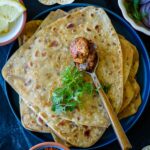Whole Wheat Triangle Parathas
Flaky, flavorful and super easy to make with just five ingredients; Triangle Parathas are great to serve with curries and sabjis. The process is quite easy and these whole wheat layered flatbreads are super easy to put together.
Servings: 8
Calories: 183kcal
Ingredients
For the dough
- 2 cups whole wheat flour
- 1 cup water
- 2 teaspoon oil
- 1 teaspoon salt
- 1 teaspoon cumin seeds
For rolling
- ¼ cup whole wheat flour
- 2 teaspoon oil
For cooking the parathas
- 3 tablespoon ghee
Instructions
- In the base of the kitchen aid add flour, cumin seeds, salt and oil.2 cups whole wheat flour, 1 teaspoon salt, 1 teaspoon cumin seeds, 2 teaspoon oil
- Add in water.1 cup water
- Place the kitchen aid bowl in the base and start bringing the dough together using a dough hook.
- Add more water if required and make a soft dough. My ideal ratio of flour to water is always 2:1.
- Place the dough ball in a bowl and rest covered for 20-30 minutes.
- Once the time is up, divide the dough into 7-8 equal parts.
- Place one dough ball on a rolling board.
- Press it down and roll the dough ball in some dry flour.¼ cup whole wheat flour
- Roll to make a 3-4 inch round.
- Apply some oil on half the round.2 teaspoon oil
- Fold over the dough round into half.
- Apply some oil on the quarter of the dough ball.
- Fold over in half. Roll again in dry flour.
- Roll the dough ball into a triangle, turning it around to prevent sticking. Also, add some dry flour if needed.
- Heat a flat tava and place the paratha on the tava.
- Once the bubbles start showing up, turn over.
- Apply some ghee and spread it evenly.3 tablespoon ghee
- Turn over and apply ghee on that side too.
- Turn over and cook the paratha completely.
- Remove from flame and serve with a curry or sabji.
Video
Notes
-
- Making the dough: The dough for paratha has to be just right. Not super hard and not super soft; the dough has to have a spring but not stick to the fingers when pushed down. The rough ratio of flour to water is 2:1 for best results.
- Using the stand mixer: The stand mixer works best to make the dough. It is great to multitask as they dough comes together while you prep something else. However, the dough can be made using the palms too.
- Resting the dough: Rest the dough for 20-30 minutes. It helps build gluten and make the dough soft and pliable. Make sure it is covered all the time so it does not dry out.
- Rolling the paratha: Roll the paratha with light hands. Take more dry flour as required. And while folding the dough ball; apply enough oil but not too much that it leaks out.
- Cooking the paratha: The parathas need to be cooked on medium flame. Only start cooking them only on a hot tava. Just flip it over twice. Flipping it too much will yield chewy parathas.
- Storing: Keep the parathas covered at all times. They tend to dry out if left open. They can be refrigerated or frozen to use later.
Nutrition
Calories: 183kcal | Carbohydrates: 24g | Protein: 5g | Fat: 8g | Saturated Fat: 4g | Polyunsaturated Fat: 1g | Monounsaturated Fat: 3g | Trans Fat: 0.01g | Cholesterol: 14mg | Sodium: 293mg | Potassium: 127mg | Fiber: 4g | Sugar: 0.1g | Vitamin A: 6IU | Vitamin C: 0.02mg | Calcium: 15mg | Iron: 1mg
